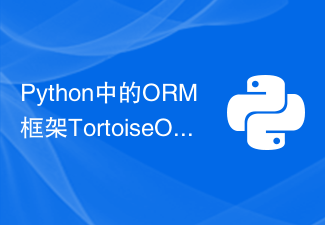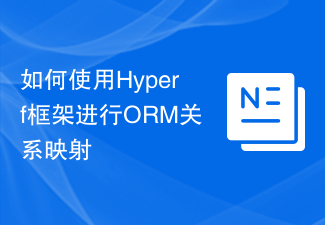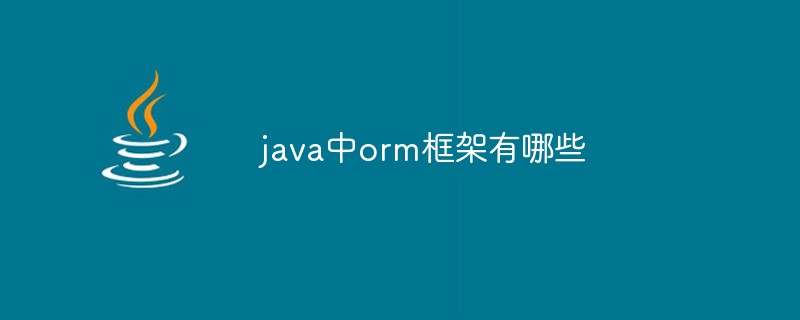 Backend Development
Backend Development PHP Tutorial
PHP Tutorial Analysis of core functions of PHP framework development: from MVC to ORM
Analysis of core functions of PHP framework development: from MVC to ORM
Analysis of the core functions of PHP framework development: from MVC to ORM
With the development of web applications, more and more PHP frameworks have emerged to help developers Build maintainable applications more efficiently. Among many frameworks, MVC and ORM are considered to be the most important core functions. This article will deeply explore the concepts, functions and applications of MVC and ORM in the PHP framework.
- MVC Architecture Pattern
MVC (Model-View-Controller) is a common software architecture pattern designed to separate different parts of an application to achieve Better maintainability and scalability.
- Model (Model): Responsible for handling data storage and business logic. It interacts with the database and provides read, write and update operations of data. Usually, a model class corresponds to a table in the database, which encapsulates data access and processing methods.
- View (View): Responsible for the presentation of the user interface and displaying data to users in a visual form. It is usually implemented through front-end technologies such as HTML, CSS and JavaScript.
- Controller (Controller): Responsible for processing user requests and calling the corresponding models and views according to the requests. It receives user input, coordinates the interaction between the model and the view, and ultimately returns results to the user.
The MVC framework provides good structure and scalability in application development. It separates business logic, data and interface, making the code easier to maintain and reuse.
- ORM: Object Relational Mapping
ORM (Object Relational Mapping) is a technology used to map between object models and relational databases. It maps records in the data table to objects in the framework, allowing developers to perform database operations through objects without directly using SQL statements.
The core idea of ORM is to establish a mapping relationship between the data table and the object model, and operating the object is equivalent to operating the database. Through ORM, developers can use an object-oriented approach to operate the database, which greatly simplifies the complexity of database operations.
In PHP framework development, ORM is usually supported by a specialized library or component. It provides a method similar to the Active Record mode, encapsulating the underlying details of database operations, allowing developers to perform database operations more conveniently.
The advantages of ORM include:
- Improved code readability: Use an object-oriented approach to write database operation code, making it easier to understand and maintain.
- Database migration and compatibility: Database migration and upgrade can be easily performed using ORM, and there is no need to manually write SQL statements anymore.
- Database operation abstraction: ORM provides an abstraction layer for database operations, allowing developers to write code that is independent of the underlying database, improving application portability.
- ORM application in MVC framework
In the PHP framework, MVC and ORM are often closely integrated. The framework provides an MVC-based architecture and also integrates ORM functions, allowing developers to develop applications more efficiently.
Developers can use the ORM function provided by the MVC framework to perform database operations in a concise object-oriented manner. Usually, the framework will provide an ORM implementation similar to the Active Record mode. Developers only need to define model classes and perform database operations by calling relevant methods.
For example, through the ORM function provided by the framework, developers can quickly complete database query, add, update and delete operations:
// 查询用户表中的记录 $user = User::find(1); // 更新用户信息 $user->name = 'John Doe'; $user->save(); // 创建新用户 $newUser = new User(); $newUser->name = 'Jane Smith'; $newUser->email = 'jane@example.com'; $newUser->save(); // 删除用户 $user->delete();
By integrating the MVC and ORM framework, developers can Build applications in a more efficient and maintainable way. The combination of these two core features provides good application architecture and improves development efficiency.
Summary:
MVC and ORM are the two core functions in PHP framework development. MVC provides a good application architecture and enables developers to separate business logic, data and interfaces. The ORM provides the function of performing database operations in an object-oriented manner, which greatly simplifies the complexity of database operations. By combining the application development framework of MVC and ORM, developers can build applications more efficiently and maintainably.
The above is the detailed content of Analysis of core functions of PHP framework development: from MVC to ORM. For more information, please follow other related articles on the PHP Chinese website!
 Python中的ORM框架Tortoise ORM实战Jun 10, 2023 pm 06:05 PM
Python中的ORM框架Tortoise ORM实战Jun 10, 2023 pm 06:05 PMTortoiseORM是一个基于Python语言开发的异步ORM框架,可用于Python异步应用程序中管理关系数据库。本文将介绍如何使用TortoiseORM框架来创建、读取、更新和删除数据,同时还将学习如何从关系数据库中执行简单和复杂的查询。准备工作在开始本教程之前,你需要安装Python(建议使用Python3.6+),同时安装TortoiseOR
 PHP中的ORMMay 24, 2023 am 08:14 AM
PHP中的ORMMay 24, 2023 am 08:14 AM随着互联网的发展,Web应用程序的开发逐渐得到了广泛应用。而其中最主要的语言之一便是PHP。然而,对于数据的管理处理却一直是开发者面临的难题。为此,ORM成为了数据处理的一个不错的选择。什么是ORM?ORM全称为Object-RelationalMapping(对象关系映射),它是一种通过使用描述对象和数据库之间映射的元数据,将面向对象编程语言程序中的对象
 如何在Phalcon框架中使用ORM(对象关系映射)?Jun 03, 2023 pm 09:21 PM
如何在Phalcon框架中使用ORM(对象关系映射)?Jun 03, 2023 pm 09:21 PM随着Web应用程序的不断发展,相应的Web开发框架也不断涌现。其中Phalcon框架因其高性能和灵活性受到了越来越多开发者的青睐。Phalcon框架提供了许多有用的组件,其中ORM(对象关系映射)被认为是最为重要的之一。本文将介绍如何在Phalcon框架中使用ORM以及一些实际应用示例。什么是ORM首先,我们需要了解什么是ORM。ORM是Object-Rel
 对象关系映射(ORM)基础知识:了解Doctrine ORMJun 19, 2023 pm 03:43 PM
对象关系映射(ORM)基础知识:了解Doctrine ORMJun 19, 2023 pm 03:43 PM对象关系映射(ORM)基础知识:了解DoctrineORM当我们开发应用程序的时候,我们需要对数据库进行操作来存储和获取数据。但是,直接使用原始的数据库查询代码很不方便。我们需要将对象和数据之间建立映射关系,这就是ORM的作用。ORM将对象和数据库表之间自动进行映射和转换,可以轻松地进行数据操作,使得我们的代码更加容易维护。DoctrineORM是PHP
 如何使用Hyperf框架进行ORM关系映射Oct 21, 2023 am 10:57 AM
如何使用Hyperf框架进行ORM关系映射Oct 21, 2023 am 10:57 AM如何使用Hyperf框架进行ORM关系映射引言:Hyperf是一个基于Swoole扩展的高性能的PHP框架,它提供了许多强大的功能和组件,包括ORM(对象关系映射)工具。本文将介绍如何使用Hyperf框架进行ORM关系映射,并提供了具体的代码示例。一、准备工作在开始之前,确保已安装好Hyperf框架,并正确配置了数据库连接信息。二、定义模型在Hyperf框架
 java中orm框架有哪些May 04, 2023 am 11:55 AM
java中orm框架有哪些May 04, 2023 am 11:55 AM1.Hiberante面向对象的ORM,学习成本比较高。2.Mybatis半自动orm框架,需要自己写sql,方便sql与java代码分离。这里所谓的“半自动”是相对于Hibernate框架全表映射而言的,MyBatis框架需要手动匹配提供POJO、SQL和映射关系,而Hibernate框架只需提供POJO和映射关系即可。3.Bee一个新的ORM框架,同时具体Hiberante和Mybatis的优点。既可像Hibernate一样通过操作对象来操作数据库,也可以像Mybatis一样灵活写sql4.
 Python中的ORM框架Pony ORM实战Jun 09, 2023 pm 10:46 PM
Python中的ORM框架Pony ORM实战Jun 09, 2023 pm 10:46 PMPython是一种高级编程语言,可用于Web开发、数据分析、人工智能等领域。在Python开发过程中,ORM(对象关系映射)框架是必不可少的一部分,ORM框架可以帮助我们轻松地将数据库和应用程序之间的数据进行交互。在本文中,我们将以PonyORM框架为例,介绍ORM框架在Python中的应用。PonyORM是Python中一款轻量级的ORM框架,与其他O
 Java语言中的ORM框架介绍Jun 10, 2023 pm 09:01 PM
Java语言中的ORM框架介绍Jun 10, 2023 pm 09:01 PM随着现代软件开发的趋势,大部分应用程序都需要与数据库进行交互。传统上,我们需要在代码中显式编写SQL语句来查询或更新数据库。然而,这种方式具有很多缺点,例如不易于维护和容易出错。为了解决这些问题,ORM(对象关系映射)框架应运而生,它允许我们在编写代码的同时,自动执行与数据库的交互。Java语言中有许多ORM框架,它们在不同领域和应用场景中都得到广泛使用。在


Hot AI Tools

Undresser.AI Undress
AI-powered app for creating realistic nude photos

AI Clothes Remover
Online AI tool for removing clothes from photos.

Undress AI Tool
Undress images for free

Clothoff.io
AI clothes remover

AI Hentai Generator
Generate AI Hentai for free.

Hot Article

Hot Tools

VSCode Windows 64-bit Download
A free and powerful IDE editor launched by Microsoft

SublimeText3 Mac version
God-level code editing software (SublimeText3)

Zend Studio 13.0.1
Powerful PHP integrated development environment

mPDF
mPDF is a PHP library that can generate PDF files from UTF-8 encoded HTML. The original author, Ian Back, wrote mPDF to output PDF files "on the fly" from his website and handle different languages. It is slower than original scripts like HTML2FPDF and produces larger files when using Unicode fonts, but supports CSS styles etc. and has a lot of enhancements. Supports almost all languages, including RTL (Arabic and Hebrew) and CJK (Chinese, Japanese and Korean). Supports nested block-level elements (such as P, DIV),

SAP NetWeaver Server Adapter for Eclipse
Integrate Eclipse with SAP NetWeaver application server.





